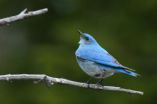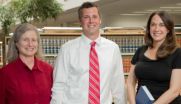(Press-News.org) CAMBRIDGE, MA -- A penny-sized rocket thruster may soon power the smallest satellites in space.
The device, designed by Paulo Lozano, an associate professor of aeronautics and astronautics at MIT, bears little resemblance to today's bulky satellite engines, which are laden with valves, pipes and heavy propellant tanks. Instead, Lozano's design is a flat, compact square — much like a computer chip — covered with 500 microscopic tips that, when stimulated with voltage, emit tiny beams of ions. Together, the array of spiky tips creates a small puff of charged particles that can help propel a shoebox-sized satellite forward.
"They're so small that you can put several [thrusters] on a vehicle," Lozano says. He adds that a small satellite outfitted with several microthrusters could "not only move to change its orbit, but do other interesting things — like turn and roll."
Lozano and his group in MIT's Space Propulsion Laboratory and Microsystems Technology Laboratory presented their new thruster array at the American Institute of Aeronautics and Astronautics' recent Joint Propulsion Conference.
Cleaning up CubeSat clutter
Today, more than two dozen small satellites, called CubeSats, orbit Earth. Each is slightly bigger than a Rubik's cube, and weighs less than three pounds. Their diminutive size classifies them as "nanosatellites," in contrast with traditional Earth-monitoring behemoths. These petite satellites are cheap to assemble, and can be launched into space relatively easily: Since they weigh very little, a rocket can carry several CubeSats as secondary payload without needing extra fuel.
But these small satellites lack propulsion systems, and once in space, are usually left to passively spin in orbits close to Earth. After a mission concludes, the satellites burn up in the lower atmosphere.
Lozano says if CubeSats were deployed at higher orbits, they would take much longer to degrade, potentially creating space clutter. As more CubeSats are launched farther from Earth in the future, the resulting debris could become a costly problem.
"These satellites could stay in space forever as trash," says Lozano, who is associate director of the Space Propulsion Laboratory. "This trash could collide with other satellites. … You could basically stop the Space Age with just a handful of collisions."
Engineering propulsion systems for small satellites could solve the problem of space junk: CubeSats could propel down to lower orbits to burn up, or even act as galactic garbage collectors, pulling retired satellites down to degrade in Earth's atmosphere. However, traditional propulsion systems have proved too bulky for nanosatellites, leaving little space on the vessels for electronics and communication equipment.
Bioinspired propulsion
In contrast, Lozano's microthruster design adds little to a satellite's overall weight. The microchip is composed of several layers of porous metal, the top layer of which is textured with 500 evenly spaced metallic tips. The bottom of the chip contains a small reservoir of liquid — a "liquid plasma" of free-floating ions that is key to the operation of the device.
To explain how the thruster works, Lozano invokes the analogy of a tree: Water from the ground is pulled up a tree through a succession of smaller and smaller pores, first in the roots, then up the trunk, and finally through the leaves, where sunshine evaporates the water as gas. Lozano's microthruster works by a similar capillary action: Each layer of metal contains smaller and smaller pores, which passively suck the ionic liquid up through the chip, to the tops of the metallic tips.
The group engineered a gold-coated plate over the chip, then applied a voltage, generating an electric field between the plate and the thruster's tips. In response, beams of ions escaped the tips, creating a thrust. The researchers found that an array of 500 tips produces 50 micronewtons of force — an amount of thrust that, on Earth, could only support a small shred of paper. But in zero-gravity space, this tiny force would be enough to propel a two-pound satellite.
Lozano and co-author Dan Courtney also found that very small increases in voltage generated a big increase in force among the thruster's 500 tips, a promising result in terms of energy efficiency.
"It means you have a lot of control with your voltage," Lozano says. "You don't have to increase a lot of voltage to attain higher current. It's a very small, modest increase."
The researchers envision a small satellite with several microthrusters, possibly oriented in different directions. When the satellite needs to propel out of orbit, onboard solar panels would temporarily activate the thrusters. In the future, Lozano predicts, microthrusters may even be used to power much larger satellites: Flat panels lined with multiple thrusters could propel a satellite through space, switching directions much like a rudder, or the tail of a fish.
"Just like solar panels you can aim at the sun, you can point the thrusters in any direction you want, and then thrust," Lozano says. "That gives you a lot of flexibility. That's pretty cool."
INFORMATION:
Written by Jennifer Chu, MIT News Office
END
Although George Church's next book doesn't hit the shelves until Oct. 2, it has already passed an enviable benchmark: 70 billion copies—roughly triple the sum of the top 100 books of all time.
And they fit on your thumbnail.
That's because Church, the Robert Winthrop Professor of Genetics at Harvard Medical School and a founding core faculty member of the Wyss Institute for Biomedical Engineering at Harvard University, and his team encoded the book, Regenesis: How Synthetic Biology Will Reinvent Nature and Ourselves, in DNA, which they then read and copied.
Biology's ...
NASA's Terra satellite passed over Tropical Storm Gordon as it continues to spin up in the North central Atlantic Ocean, and revealed the storm has become less symmetric, indicating it is being battered by wind shear.
When Terra passed over Gordon on August 16, 2012 at 10:25 a.m. EDT (1425 UTC) the Moderate Resolution Imaging Spectroradiometer (MODIS) instrument captured a visible image of the storm. The image showed that the bulk of Gordon's clouds were pushed to the north and northeast as a result of southwesterly wind shear. The MODIS image showed what appeared to ...
Berkeley — Two new studies by scientists at the University of California, Berkeley, provide a clearer picture of why some species move in response to climate change, and where they go.
One study, published online Monday, Aug. 6, in the journal Global Change Biology, finds that changes in precipitation have been underappreciated as a factor in driving bird species out of their normal range. In the other study, published today (Wednesday, Aug. 15) in the journal Proceedings of the Royal Society B, researchers found a sharp decrease in range for the Belding's ground squirrel, ...
Highlights
Vancomycin was the most commonly prescribed antibiotic in dialysis patients for treating certain bloodstream infections, but cefazolin was 38% better than vancomycin at preventing hospitalizations and deaths from these infections.
Cefazolin was also 48% better at preventing sepsis.
Hundreds of thousands of Americans develop bloodstream infections every year.
Washington, DC (August 16, 2012) — The antibiotic most commonly prescribed to treat bloodstream infections in dialysis patients may not always be the best choice, according to a study appearing ...
Highlights
The blood levels of certain abnormal proteins and the antibodies that attack them rise according to the severity of one of the most common diseases of the kidney.
The findings may help in the diagnosis and management of the disease, called IgA nephropathy.
IgA nephropathy can lead to high blood pressure, swelling and, in some cases, kidney failure.
Washington, DC (August 16, 2012) — Increasing blood levels of particular proteins may act as warning signs for patients with one of the most common diseases of the kidney, according to a study appearing ...
Highlights
Approximately 1 in 40 men and 1 in 60 women of middle age will develop kidney failure if they live into their 90s.
People with reduced kidney function face an even higher risk.
Kidney failure is on the rise and currently afflicts 2 million people worldwide.
Washington, DC (August 16, 2012) — How likely are middle-aged adults to develop kidney failure during their lifetime? A study appearing in an upcoming issue of the Journal of the American Society of Nephrology (JASN) provides some insights, which may be used to help set priorities related to kidney ...
SALT LAKE CITY, Aug. 16, 2012 – A University of Utah survey of judges in 19 states found that if a convicted criminal is a psychopath, judges consider it an aggravating factor in sentencing, but if judges also hear biological explanations for the disorder, they reduce the sentence by about a year on average.
The new study, published in the Aug. 17, 2012, issue of the journal Science, illustrates the "double-edged sword" faced by judges when they are given a "biomechanical" explanation for a criminal's mental disorder:
If a criminal's behavior has a biological basis, ...
What if a key factor ultimately behind a cancer was not a genetic defect but ecological?
Ecologists have long known that when some major change disturbs an environment in some way, ecosystem structure is likely to change dramatically. Further, this shift in interconnected species' diversity, abundances, and relationships can in turn have a transforming effect on health of the whole landscape – causing a rich woodland or grassland to become permanently degraded, for example – as the ecosystem becomes unstable and then breaks down the environment.
For this reason, it ...
High baseline levels of neuronal activity in the best connected parts of the brain may play an important role in the development of Alzheimer's disease. This is the main conclusion of a new study appearing in PLoS Computational Biology from a group at VU University Medical Center in Amsterdam, the Netherlands.
In recent times, it has become clear that brain activity patterns change at an early stage in Alzheimer's disease. Moreover, there is reason to believe that, instead of being the consequence of structural damage, they might be the cause: recently, a direct influence ...
In uncertain environments, organisms not only react to signals, but also use molecular processes to make guesses about the future, according to a study by Markus Arnoldini et al. from ETH Zurich and Eawag, the Swiss Federal Institute of Aquatic Science and Technology. The authors report in PLoS Computational Biology that if environmental signals are unreliable, organisms are expected to evolve the ability to take random decisions about adapting to cope with adverse situations.
Most organisms live in ever-changing environments, and are at times exposed to adverse conditions ...


